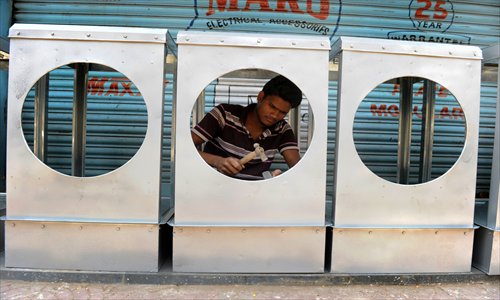HOME >> BUSINESS
China can hold steady even as Indian growth sags
By Hu Weijia Source:Global Times Published: 2019/9/19 22:13:41

An Indian worker constructs the metal skeletal frame of an air cooler at his workshop in Hyderabad on Sunday. Air coolers are in high demand during the summer months as temperatures rise above 40 C in many places on the Indian subcontinent. Photo: AFP
Global investors have sold $4.5 billion worth of Indian shares since June, the South China Morning Post (SCMP) reported, news that adds to the evidence that the Indian economy has begun to lose its luster.Fears of a global economic slowdown are rising as reliable figures indicate that both developed and developing economies have been hit hard by issues such as the US-launched trade war.
India, as a newcomer to the list of manufacturing powers, has showed less resilience to external uncertainties amid global economic slowdown.
India's GDP growth tumbled to a six-year low of 5 percent in the April-June quarter. Although a stimulus plan has been unveiled, confidence in the economy is giving way to uncertainty. Indian Prime Minister Narendra Modi is facing the most serious economic challenge since he took power in 2014.
India's growth has been very capital-intensive. With the "Make in India" campaign having been initiated by the Modi government, India has liberalized its foreign direct investment rules for labor-intensive industries, trying to make itself an attractive destination for foreign capital.
But the growth of an export-oriented economy in India gives the country less tolerance for external uncertainties. Its labor-intensive industries remain vulnerable amid a global economic slowdown due to the lack of proprietary intellectual property rights.
Not only India but also Vietnam, Mexico and other emerging economies that have plugged into global value chains by manufacturing labor-intensive goods are having a hard time as consumption declines in the US and EU nations.
The US Federal Reserve has cut interest rates for only the second time since 2008, amid concerns about a bleak economic outlook. Personal-consumption expenditures, a measure of household spending, barely increased in July from June in the US, with a seasonally adjusted gain of 0.6 percent.
The risks of a recession have spread along the global value chain from ultimate consumer markets to labor-intensive economies such as India and Vietnam. We hope that the complete industrial chain built in China and the nation's growing middle class can give more scope for Beijing to counter the slowdown in the global economy.
It is estimated that the contribution of China's GDP growth to the world economy is expected to remain at about 30 percent this year.
India's economic slump risks becoming a crisis, but it doesn't mean that China is fated to follow India's steps.
The author is a reporter with the Global Times. bizopinion@globaltimes.com.cn
Posted in: EYE ON ECONOMY